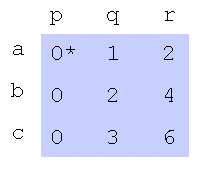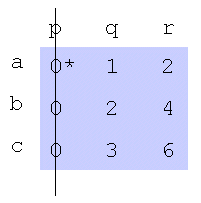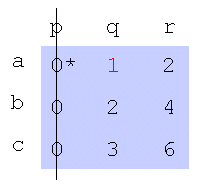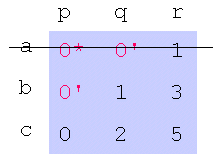图解匈牙利算法(含python代码)
文章目录
- 分配问题
- 匈牙利算法
-
- 算法步骤
- 算法实现
-
- python版本
- C++版本
分配问题
分配问题/指派问题(Assignment Problem)作为线性规划问题的一个特例,在运筹学研究中占有重要的地位,一直受到广泛的重视。
假如有n个工人和n项工作,每个工人只能执行一个工作,并且每个工作只能分配给一个工人,每个工人做不同类型工作的成本是不同的。如何将这n项工作分配给这n个工人,从而使得总体成本最低。
用矩阵 C ( i , j ) C(i,j) C(i,j)来表示n个工人中每个个工人执行不同工作的成本。分配问题就是将工作分配给工人,以使总成本最小化。1

如果想找到成本最低的分配,最直观的方法是运用暴力穷举。对于nxn的矩阵来说,第一行有n个选择,第二行有n-1个选择,以此类推,总共有 n ! n! n!种可能的选择,时间复杂度在指数级,计算成本太高。
所以,James Munkre在1950年代提出匈牙利算法,用于解决分配问题/指派问题,时间复杂度在多项式级,最坏情况下的O(n3)2。
匈牙利算法
算法步骤
步骤0: 创建一个称为成本矩阵的nxm矩阵,其中每个元素代表将n个工人之一分配给m个工作之一的成本。旋转矩阵,以便至少有与行一样多的列,并令K= min(n,m)。

步骤1: 对于矩阵的每一行,找到最小的元素,并将其从其行中的每个元素中减去。转到步骤2。

步骤2: 在生成的矩阵中找到0(Z)。如果其行或列中没有加星号的零,请加星号Z。对矩阵中的每个元素重复此操作。转到步骤3。

步骤3: 覆盖有0*的每一列。如果覆盖了K列,则加星号的零表示完整的唯一赋值集。在这种情况下,请转到“完成”,否则,请转到步骤4。步骤3是贪婪方法的示例。如果最小值全部在不同的行中,则它们的位置表示最小的成对分配。

步骤4: 找到一个未覆盖的零并将其准备好。如果包含0 *的行中没有准备好的0’,请转到步骤5。否则,覆盖该行并找出包含0 *的列。继续以这种方式进行操作,直到没有剩余的零为止。保存最小的发现值,然后转到步骤6。

步骤5:构造如下一系列交替的填色和加星号的零:
令Z0代表在步骤4中发现的未覆盖的准备好的零 0’。
令Z1表示Z0列中的星号零 0*(如果有的话)。
令Z2表示Z1行中的准备好的零 0’(始终为1个)。
继续直到0’所在列没有星标零 0*,终止该序列。取消对每个已加星标的零的星标,对系列中的每个0’加星标,去除所有的’和覆盖线。 步骤5是增强路径算法(稳定婚姻问题)的示例。



返回步骤3。



步骤6: 将在第4步中找到的最小值添加到每个覆盖行的每个元素中,并将其从每个未覆盖列的每个元素中减去。返回第4步,而不更改任何星号,或遮盖线。
完成: 分配对由成本矩阵中加星号的零的位置指示。如果C(i,j)为星号零,则将与行i关联的元素分配给与列j关联的元素。
算法实现
python版本
scipy中有对应的接口scipy.optimize.linear_sum_assignment3,输入代价矩阵,即可得到分配问题的结果:
>>> cost = np.array([[4, 1, 3], [2, 0, 5], [3, 2, 2]])
>>> from scipy.optimize import linear_sum_assignment
>>> row_ind, col_ind = linear_sum_assignment(cost)
>>> col_ind
array([1, 0, 2])
>>> cost[row_ind, col_ind].sum()
5
scipy.optimize.linear_sum_assignment的源码如下4:
# Hungarian algorithm (Kuhn-Munkres) for solving the linear sum assignment
# problem. Taken from scikit-learn. Based on original code by Brian Clapper,
# adapted to NumPy by Gael Varoquaux.
# Further improvements by Ben Root, Vlad Niculae and Lars Buitinck.
#
# Copyright (c) 2008 Brian M. Clapper , Gael Varoquaux
# Author: Brian M. Clapper, Gael Varoquaux
# License: 3-clause BSD
import numpy as np
def linear_sum_assignment(cost_matrix):
"""Solve the linear sum assignment problem.
The linear sum assignment problem is also known as minimum weight matching
in bipartite graphs. A problem instance is described by a matrix C, where
each C[i,j] is the cost of matching vertex i of the first partite set
(a "worker") and vertex j of the second set (a "job"). The goal is to find
a complete assignment of workers to jobs of minimal cost.
Formally, let X be a boolean matrix where :math:`X[i,j] = 1` iff row i is
assigned to column j. Then the optimal assignment has cost
.. math::
\min \sum_i \sum_j C_{i,j} X_{i,j}
s.t. each row is assignment to at most one column, and each column to at
most one row.
This function can also solve a generalization of the classic assignment
problem where the cost matrix is rectangular. If it has more rows than
columns, then not every row needs to be assigned to a column, and vice
versa.
The method used is the Hungarian algorithm, also known as the Munkres or
Kuhn-Munkres algorithm.
Parameters
----------
cost_matrix : array
The cost matrix of the bipartite graph.
Returns
-------
row_ind, col_ind : array
An array of row indices and one of corresponding column indices giving
the optimal assignment. The cost of the assignment can be computed
as ``cost_matrix[row_ind, col_ind].sum()``. The row indices will be
sorted; in the case of a square cost matrix they will be equal to
``numpy.arange(cost_matrix.shape[0])``.
Notes
-----
.. versionadded:: 0.17.0
Examples
--------
>>> cost = np.array([[4, 1, 3], [2, 0, 5], [3, 2, 2]])
>>> from scipy.optimize import linear_sum_assignment
>>> row_ind, col_ind = linear_sum_assignment(cost)
>>> col_ind
array([1, 0, 2])
>>> cost[row_ind, col_ind].sum()
5
References
----------
1. http://csclab.murraystate.edu/bob.pilgrim/445/munkres.html
2. Harold W. Kuhn. The Hungarian Method for the assignment problem.
*Naval Research Logistics Quarterly*, 2:83-97, 1955.
3. Harold W. Kuhn. Variants of the Hungarian method for assignment
problems. *Naval Research Logistics Quarterly*, 3: 253-258, 1956.
4. Munkres, J. Algorithms for the Assignment and Transportation Problems.
*J. SIAM*, 5(1):32-38, March, 1957.
5. https://en.wikipedia.org/wiki/Hungarian_algorithm
"""
cost_matrix = np.asarray(cost_matrix)
if len(cost_matrix.shape) != 2:
raise ValueError("expected a matrix (2-d array), got a %r array"
% (cost_matrix.shape,))
# The algorithm expects more columns than rows in the cost matrix.
'''代价矩阵需要列数 ≥ 行数'''
if cost_matrix.shape[1] < cost_matrix.shape[0]:
cost_matrix = cost_matrix.T
transposed = True
else:
transposed = False
state = _Hungary(cost_matrix)
# No need to bother with assignments if one of the dimensions
# of the cost matrix is zero-length.
step = None if 0 in cost_matrix.shape else _step1
while step is not None:
step = step(state)
if transposed:
marked = state.marked.T
else:
marked = state.marked
return np.where(marked == 1)
class _Hungary(object):
"""State of the Hungarian algorithm.
Parameters
----------
cost_matrix : 2D matrix
The cost matrix. Must have shape[1] >= shape[0].
"""
def __init__(self, cost_matrix):
self.C = cost_matrix.copy()
n, m = self.C.shape
self.row_uncovered = np.ones(n, dtype=bool)
self.col_uncovered = np.ones(m, dtype=bool)
self.Z0_r = 0
self.Z0_c = 0
self.path = np.zeros((n + m, 2), dtype=int)
self.marked = np.zeros((n, m), dtype=int)
def _clear_covers(self):
"""Clear all covered matrix cells"""
self.row_uncovered[:] = True
self.col_uncovered[:] = True
# Individual steps of the algorithm follow, as a state machine: they return
# the next step to be taken (function to be called), if any.
def _step1(state):
"""Steps 1 and 2 in the Wikipedia page."""
"""
Step 1: For each row of the matrix, find the smallest element and
subtract it from every element in its row.
减去每一行的最小值
"""
state.C -= state.C.min(axis=1)[:, np.newaxis]
"""
Step 2: Find a zero (Z) in the resulting matrix. If there is no
starred zero in its row or column, star Z. Repeat for each element
in the matrix.
如果一行或列中没有星标的0,则标记0*
"""
for i, j in zip(*np.where(state.C == 0)):
if state.col_uncovered[j] and state.row_uncovered[i]:
state.marked[i, j] = 1
state.col_uncovered[j] = False
state.row_uncovered[i] = False
state._clear_covers()
return _step3
def _step3(state):
"""
Step3:Cover each column containing a starred zero. If n columns are covered,
the starred zeros describe a complete set of unique assignments.
In this case, Go to DONE, otherwise, Go to Step 4.
覆盖每列包含加星号的零。如果覆盖了n列,加星号的零表示完整的唯一结果集。
"""
marked = (state.marked == 1)
state.col_uncovered[np.any(marked, axis=0)] = False
if marked.sum() < state.C.shape[0]:
return _step4
def _step4(state):
"""
Step4:Find a noncovered zero and prime it. If there is no starred zero
in the row containing this primed zero, Go to Step 5. Otherwise,
cover this row and uncover the column containing the starred
zero. Continue in this manner until there are no uncovered zeros
left. Save the smallest uncovered value and Go to Step 6.
找到一个未覆盖的零并将其准备好。 如果准备好的零所在行中没有加星号的零,
请转到步骤5。否则,覆盖该行并找出包含加注星号的零的列。 继续以这种方式
进行操作,直到没有剩余的零为止。保存最小的发现值,然后转到步骤6。
"""
# We convert to int as numpy operations are faster on int
C = (state.C == 0).astype(int)
covered_C = C * state.row_uncovered[:, np.newaxis]
covered_C *= np.asarray(state.col_uncovered, dtype=int)
n = state.C.shape[0]
m = state.C.shape[1]
while True:
# Find an uncovered zero
row, col = np.unravel_index(np.argmax(covered_C), (n, m))
if covered_C[row, col] == 0:
return _step6
else:
state.marked[row, col] = 2
# Find the first starred element in the row
star_col = np.argmax(state.marked[row] == 1)
if state.marked[row, star_col] != 1:
# Could not find one
state.Z0_r = row
state.Z0_c = col
return _step5
else:
col = star_col
state.row_uncovered[row] = False
state.col_uncovered[col] = True
covered_C[:, col] = C[:, col] * (
np.asarray(state.row_uncovered, dtype=int))
covered_C[row] = 0
def _step5(state):
"""
Step5:Construct a series of alternating primed and starred zeros as follows.
Let Z0 represent the uncovered primed zero found in Step 4.
Let Z1 denote the starred zero in the column of Z0 (if any).
Let Z2 denote the primed zero in the row of Z1 (there will always be one).
Continue until the series terminates at a primed zero that has no starred
zero in its column. Unstar each starred zero of the series, star each
primed zero of the series, erase all primes and uncover every line in the
matrix. Return to Step 3
构造如下一系列交替的填色和加星号的零:
令Z0代表在步骤4中发现的未覆盖的准备好的零 0'。
令Z1表示Z0列中的星号零 0*(如果有的话)。
令Z2表示Z1行中的准备好的零 0'(始终为1个)。
继续直到0'所在列没有星标0*,终止该序列。取消对每个已加星标的零的星标,对系列中的每个0'加星标,去除所有的'和覆盖线。 返回步骤3。
"""
count = 0
path = state.path
path[count, 0] = state.Z0_r
path[count, 1] = state.Z0_c
while True:
# Find the first starred element in the col defined by
# the path.
row = np.argmax(state.marked[:, path[count, 1]] == 1)
if state.marked[row, path[count, 1]] != 1:
# Could not find one
break
else:
count += 1
path[count, 0] = row
path[count, 1] = path[count - 1, 1]
# Find the first prime element in the row defined by the
# first path step
col = np.argmax(state.marked[path[count, 0]] == 2)
if state.marked[row, col] != 2:
col = -1
count += 1
path[count, 0] = path[count - 1, 0]
path[count, 1] = col
# Convert paths
for i in range(count + 1):
if state.marked[path[i, 0], path[i, 1]] == 1:
state.marked[path[i, 0], path[i, 1]] = 0
else:
state.marked[path[i, 0], path[i, 1]] = 1
state._clear_covers()
# Erase all prime markings
state.marked[state.marked == 2] = 0
return _step3
def _step6(state):
"""
Step 6: Add the value found in Step 4 to every element of each covered row,
and subtract it from every element of each uncovered column.
Return to Step 4 without altering any stars, primes, or covered lines.
将在第4步中找到的值添加到每个覆盖行的每个元素中,
并将其从每个未覆盖列的每个元素中减去。
返回第4步,而不更改任何星号,或遮盖线。
"""
# the smallest uncovered value in the matrix
if np.any(state.row_uncovered) and np.any(state.col_uncovered):
minval = np.min(state.C[state.row_uncovered], axis=0)
minval = np.min(minval[state.col_uncovered])
state.C[~state.row_uncovered] += minval
state.C[:, state.col_uncovered] -= minval
return _step4
C++版本
参考多目标跟踪项目中的实现:github
https://brc2.com/the-algorithm-workshop/ ↩︎
Jin K W . A new implementation of an algorithm for the optimal assignment problem: An improved version of Munkres’ algorithm[J]. Bit Numerical Mathematics, 1979, 19(3):418-424. ↩︎
https://docs.scipy.org/doc/scipy/reference/generated/scipy.optimize.linear_sum_assignment.html ↩︎
https://github.com/scipy/scipy/blob/v0.18.1/scipy/optimize/_hungarian.py#L13-L107 ↩︎





